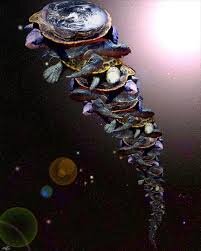Quoting from the vacuum state paper linked by Steve:
". . . Tibetan contemplatives describe the substrate as the objective, empty space of the mind. This vacuum state is immaterial like space, a blank, unthinking void into which all objective appearances of the physical senses and [5] mental perception dissolve when one falls asleep; and it is out of this vacuum that appearances re-emerge upon waking.[6] The subjective consciousness of this mental vacuum is called the substrate consciousness. In the natural course of a life, this is repeatedly experienced in dreamless sleep and finally experienced in the moment before death. A contemplative may consciously probe this dimension of consciousness through the practice of meditative quiescence, in which discursive thoughts become dormant and all appearances of oneself, others, one’s body and one’s environment vanish. At this point, as in the cases of sleeping and dying, the mind is drawn inwards and the physical senses become dormant. What remains is a state of radiant, clear consciousness that is the basis for the emergence of all appearances to an individual’s mind-stream. All phenomena appearing to sensory and mental perception are imbued with the clarity of this substrate consciousness. Like the reflections of the planets and stars in a pool of limpid, clear water, so do the appearances of the entire phenomenal world appear within this empty, clear substrate consciousness. Contemplatives who have penetrated to this state of consciousness describe it as 'an unfluctuating state, in which one experiences bliss like the warmth of a fire, luminosity like the dawn, and nonconceptuality like an ocean unmoved by waves.'[7]
The above description can easily be misinterpreted as an expression of philosophical idealism. However, these contemplatives are not claiming that the entire universe is of the nature of the mind, only that one’s individual world of appearances arises from this substrate consciousness. Moreover, the qualities of bliss, luminosity, and nonconceptuality associated with the realization of the substrate consciousness have led many contemplatives to mistake this for the ultimate nature of reality, or nirvana. But simply dwelling in this relative vacuum state of consciousness does not liberate the mind of its afflictive tendencies or their resultant suffering. By fathoming the nature of the substrate consciousness, one comes to know the nature of consciousness in its relative ground state. This realization, however, does not illuminate the nature of reality as a whole. It is also important not to confuse this substrate consciousness with a collective unconscious, as conceived by Carl Jung. Buddhist accounts of the substrate consciousness all refer to it as an individual stream of consciousness that carries on from one lifetime to the next. . . . ."
I have no doubt that contemplatives, mystics, and disciplined meditators (as in the Buddhist tradition) discover aspects of Reality/What-Is through their motivations and efforts to escape conflicts and suffering arising in what is thought as 'duality' in their cultures. Nevertheless, I see their experiences as 'time-outs' from the general conditions of the lived and emotionally felt experiences of embodied consciousnesses in a physically evolving world. It seems inescapable to me that consciousness and human mind have evolved in a physically evolving world, out of "the body of the world" as WS expresses it. At the same time, within temporal existence in the physical world, we are subject to marginal, liminal, influences that penetrate our consciousnesses from beyond or behind the conditions/states of being that our species endures in waking consciousness, and which we have come to recognize as 'supra-normal' experiences not explicable in the terms of what we have needed and/or preferred to think of as 'normal' and 'natural'.
The early modern theoretical psychologists {Freud, Jung, and Frederick W.H. Myers} increasingly identified 'abnormal' and also 'supranormal' ideation and experiences in terms of 'subliminal' consciousness, gradually recognizing (it seems to me) precincts of the history of the evolution of consciousness yet unwritten, unexplicated, in their time and still in our own time, yet clearly accessible by our species' embodied consciousness.

